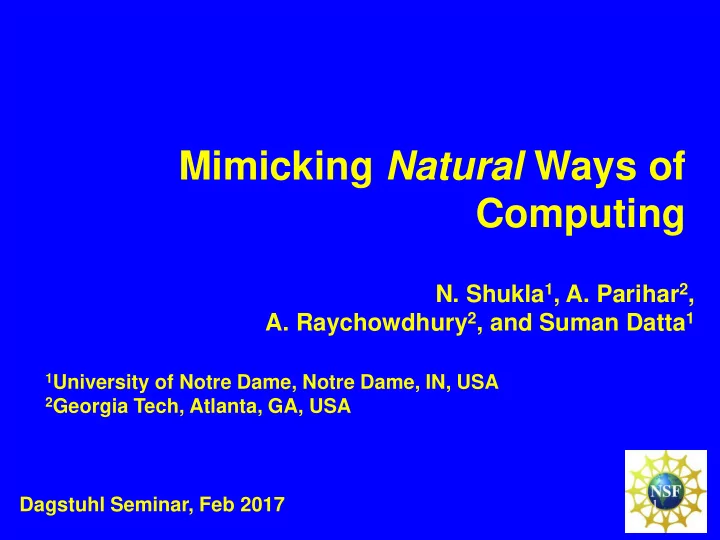

Mimicking Natural Ways of Computing N. Shukla 1 , A. Parihar 2 , A. Raychowdhury 2 , and Suman Datta 1 1 University of Notre Dame, Notre Dame, IN, USA 2 Georgia Tech, Atlanta, GA, USA Dagstuhl Seminar, Feb 2017 1
Natural Ways of Computing
Natural Ways of Computing
Prediction
EXCEL (sponsored by NSF/NRI) Notre Dame, Georgia Tech, Penn St, U Chicago, UC San Diego
Computational Paradigms Coupled Dynamical Systems Many body analog computing with both feedback and feedforward dynamics Potential super-Turing capabilities (debatable) Compatible with CMOS Room temperature operation
Vertex Coloring of Graphs time evolution of the dynamical system created by the coupled oscillator circuit correspond to an approximate vertex color sorting algorithm Parihar, Shukla et a “Vertex coloring of graphs via phase dynamics of coupled oscillatory networks“ (submitted to Nature Scientific Reports)
Coupled Oscillatory Systems CMOS PLLs Synchronization of Metronomes Shibata, Tadashi, et al. "CMOS supporting circuitries for nano-oscillator-based https://www.youtube.com/watch?v=JWToUATLGzs; (Ikelguchi Lab) associative memories.“ CNNA, 2012 13th International Workshop on . IEEE, 2012. Opto-mechanical Oscillators Spin Torque Nano Oscillators Free layer Fixed layer 8 Kaka, Shehzaad, Matthew R. Pufall, William H. Rippard, Thomas J. Silva, Zhang, Mian, et al. "Synchronization of micromechanical oscillators Stephen E. Russek, and Jordan A. Katine. "Mutual phase-locking of microwave using light." Physical review letters 109.23 (2012): 233906. spin torque nano-oscillators." Nature 437, no. 7057 (2005): 389-392.
Thermally driven Insulator-metal phase transition in VO 2 Insulating VO 2 0 10 Resistivity ( Ω .cm) insulator -1 10 monoclinic -2 10 Metallic VO 2 -3 10 metal -4 10 240 270 300 330 Temperature (K) rutile Abrupt change in VO 2 resistivity through electron correlation dynamics in ultra-thin VO 2 films. 9 M. Huefner, R. Ghosh, E. Freeman, N. Shulka, H. Paik, D. G. Schlom, and S. Datta "Hubbard Gap Modulation in Vanadium Dioxide Nanoscale Tunnel Junctions", Nano Letters , October 2014.
Electrically induced “abrupt”, “reversible” and “hysteretic” phase transition 2.0 V DC Current ( mA ) 1.5 1.0 metal 0.5 insulator 0.0 0 20 40 Electric Field (kV/cm) Abrupt, hysteretic phase transition can be electrically triggered 10
VO 2 based Relaxation Oscillators V DC V DC V DC V DC t VO 2 VO 2 I M M I V 1 V 1 C C R S R S V 1 V 1 experiment 12 R S V 1 (V) 10 V 1 V 1 t 8 t t 6 0 50 100 150 Time ( µ s) Negative feedback by series resistor (R S ) enable oscillations 11
Hybrid VO 2 -MOSFET (HVFET) oscillator V DC 100 V DC 15 t Frequency (kHz) V 1 (V) 80 10 V 1 5 60 0 50 100 150 Time ( µ s ) t 40 V GS V 1 20 D S 0 Si substrate 0.0 0.2 0.4 0.6 0.8 V GS (V) Voltage controlled VO 2 oscillator realized by replacing R S with a MOSFET (HVFET Oscillator) 12
Pairwise Coupled HVFET Oscillators V DC 0 V 1 V DC V DC t V 2 -10 V 2 Power (dB) -20 t V 1 -30 V 2 (output) V 1 (output) V GS,2 V GS,1 -40 C C t Resonant S D D S frequency -50 Si substrate 0 10 20 30 Frequency (kHz) C C = 2.2nF Capacitively coupled oscillators show frequency synchronization 13
Equivalent Circuit for coupled HVFET Oscillators R VO 2 R VO 2 V MOS C C V MOS 2 1 g 0 g 0 V GS,2 + V GS,1 + C 2 C 1 - - g m V gs g m V gs MOSFET MOSFET Equivalent circuit to analyze synchronization dynamics of pairwise coupled HVFET oscillators 14
Phase Space Diagram (locking / unlocking) Δ V GS =-0.02 V Δ V GS =-0.2 V V DC V DC VO 2 VO 2 C C Locked Unlocked Δ V GS =0.02 V Δ V GS =0.2 V V gs1 V gs2 Δ V GS =V GS,2 -V GS,1 Locked Unlocked Gate Input voltage difference decides synchronization 15
Experiments vs Simulation 16
Degree of Locking (Locked Case) V GS,1 = 0.3V V GS,1 = 0.3V V GS,1 = 0.3V V GS,2 = 0.32V V GS,2 = 0.35V V GS,2 = 0.3V 0.8 0.8 0.8 V 2 (V) P 0.7 0.7 0.7 0.6 0.6 0.6 0.6 0.7 0.8 0.6 0.7 0.8 0.6 0.7 0.8 V 1 (V) XOR=0 Part of steady state periodic orbit in the XOR=0 region of the phase space depends on Δ V GS = V GS,2 - V GS,1 17
Phase Difference measurement V 1 Coupled Output Time XOR Oscillator Threshold Average Output V 2 System implementation to measure steady state periodic orbit of the HVFET oscillators 18
Graph Coloring Experiments Net phase of any oscillator is the aggregate of the ‘repelling effect’ of all the adjacent oscillators 19
Connectivity of Graphs Tradeoff between settling time and # of colors detected (as a function of average connectivity) 20
Heuristics vs Dynamical System DIMACS implementation challenge Dynamical systems can outperform heuristic algorithms in some cases 21
Connection between Phase Dynamics of coupled oscillator system and spectral techniques of solving graph coloring problems provides a new way to think about next generation computing systems Perhaps we can finally realize the true potential of beyond-CMOS devices by matching the “physics” of emerging nanodevices to the “mathematics” of the computing” 22
Recommend
More recommend